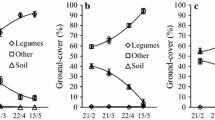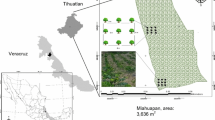Abstract
Mature almond trees bear fruit mainly on short shoots called spurs, with only a small percentage of fruit produced laterally on long 1-year-old shoots. As a result, maintenance of large numbers of healthy spurs per tree is critical for fruit production. However, spurs that bear fruit have lower leaf area, leaf nitrogen content, and CO2 assimilation rate than non-fruiting spurs. This has been correlated with reduced percentages of spur survival and return bloom the following season. Thus, we hypothesized that spur leaf area, and ultimately spur health could be enhanced through application of foliar sprays and soil nitrogen treatments that would enhance leaf nitrogen content and spur leaf area. To test our hypothesis, we selected almond trees exhibiting significant yield differences as a consequence of differential soil rates of nitrogen fertilization (N rate) for three prior years (140, 224, and 392 kg/ha). In each tree, three spur types [non-fruiting spurs (F0); spurs with one fruit (F1); spurs with two fruit (F2)] were selected on the east side of the canopy and tracked for one complete season (2011–2012). Four foliar treatments (nutrient replacement, nutrient replacement with biostimulant, nitrogen, and non-spray) were directly applied to individual spurs in each N rate in the spring of 2011 and characteristic such as leaf nitrogen, and fruit quality were recorded throughout the season. In winter of 2012, spur survival and return bloom were addressed through individual visual inspection of the tagged spurs. In this experiment, soil and foliar N treatments effectively increased spur leaf area, fruit, and leaf nitrogen concentration. In the high N treatment, the leaf nitrogen values exceeded the critical nitrogen concentration established for almond trees and the critical leaf area for spur survival and blooming thresholds established by past research in this area. However, none of these positive changes in leaf N or leaf area improved spur survival and/or return boom of any spur type. Indeed, survival and hull + shell weight tended to be lower in the population of fruiting spurs with the highest leaf area and leaf nitrogen concentration and the return bloom probabilities were always lower in fruiting spurs than in non-fruiting spurs, independent of the nitrogen rate. These results and the relationship between nitrogen rate and spur survival are discussed.





Similar content being viewed by others
References
AOAC (2006) Microchemical Determination of Carbon, Hydrogen, and Nitrogen, Automated Method. In: Official Methods of Analysis of AOAC International, 18th edn. Gaithersburg, pp 5–6
Bates DM, Maechler M, Bolker B, Walker S (2013) lme4: linear mixed-effects models using Eigen and S4. R package version 1.0-5. CRAN.R-project
Bi G, Scagel CF, Cheng L, Dong S, Fuchigami LH (2003) Spring growth of almond nursery trees depends upon nitrogen from both plant reserves and spring fertilizer application. J Hortic Sci Biotechnol 78:853–858
Chan BG, Cain JC (1967) Effect of seed formation on subsequent flowering in Apple. Proc Am Soc Hortic Sci 91:63–68
Chen LS, Cheng LL (2004) Photosynthetic enzymes and carbohydrate metabolism of apple leaves in response to nitrogen limitation. J Hortic Sci Biotechnol 79:923–929
Dejong TM, Doyle JF (1985) Seasonal relationships between leaf nitrogen-content (photosynthetic capacity) and leaf canopy light exposure in peach (Prunus persica). Plant Cell Environ 8:701–706
DeJong TM, Day KR, Johnson RS (1989) Partitioning of leaf nitrogen with respect to within canopy light exposure and nitrogen availability in peach (Prunus persica). Trees Struct Funct 3:89–95
Egea G, Gonzalez-Real MM, Baille A, Nortes PA, Sanchez-Bel P, Domingo R (2009) The effects of contrasted deficit irrigation strategies on the fruit growth and kernel quality of mature almond trees. Agric Water Manag 96:1605–1614
Evans JR (1989) Photosynthesis and nitrogen relationships in leaves of C-3 plants. Oecologia 78:9–19
Fox J, Weisberg S (2011) An R companion to applied regression, 2nd edn. SAGE Publications, Los Angeles
Gonzalez-Rossia D, Reig C, Juan M, Agusti M (2007) Horticultural factors regulating effectiveness of GA(3) inhibiting flowering in peaches and nectarines (Prunus persica L. Batsch). Sci Hortic 111:352–357
Hawker JS, Buttrose MS (1980) Development of the almond nut (Prunus dulcis (Mill) webb, D.A.)—anatomy and chemical-composition of fruit parts from anthesis to maturity. Ann Bot 46:313–321
Heerema RJ, Weinbaum SA, Pernice F, Dejong TM (2008) Spur survival and return bloom in almond Prunus dulcis (Mill.) DAWebb varied with spur fruit load, specific leaf weight, and leaf area. J Hortic Sci Biotechnol 83:274–281
Heerema RJ, Weinbaum SA, Lampinen BD, Dejong TM (2009) Is nitrogen stress more apparent in shaded, fruiting almond spurs than in exposed, non-fruiting spurs? J Hortic Sci Biotechnol 84:355–359
Kester DE, Martin GC, Labavitch JM (1996) Growth and development. Almond Production Manual. University of California Division of Agricultural and Natural Resources, Oakland, pp 90–97
Klein I, Dejong TM, Weinbaum SA, Muraoka TT (1991) Specific leaf weight and nitrogen allocation responses to light exposure within walnut trees. HortScience 26:183–185
Lamp BM, Connell JH, Duncan RA, Viveros M, Polito VS (2001) Almond flower development: floral initiation and organogenesis. J Am Soc Hortic Sci 126:689–696
Lampinen BD, Tombesi S, Metcalf SG, DeJong TM (2011) Spur behaviour in almond trees: relationships between previous year spur leaf area, fruit bearing and mortality. Tree Physiol 31:700–706
Martinez-Fuentes A, Mesejo C, Reig C, Agusti M (2010) Timing of the inhibitory effect of fruit on return bloom of ‘Valencia’ sweet orange (Citrus sinensis (L.) Osbeck). J Sci Food Agric 90:1936–1943
Muhammad S et al (2015) Seasonal changes in nutrient content and concentrations in a mature deciduous tree species: studies in almond (Prunus dulcis (Mill.) D. A. Webb). Eur J Agron 65:52–68
Neilsen JC, Dennis FG Jr. (2000) Effects of seed number, time of defruiting, and bourse shoot length on flowering in apple. HortScience, pp 137–146
Nortes PA, Gonzalez-Real MM, Egea G, Baille A (2009) Seasonal effects of deficit irrigation on leaf photosynthetic traits of fruiting and non-fruiting shoots in almond trees. Tree Physiol 29:375–388
Ouzounis T, Lang GA (2011) Foliar applications of urea affect nitrogen reserves and cold acclimation of sweet cherries (Prunus avium L.) on dwarfing rootstocks. HortScience 46:1015–1021
Pinheiro JC, Bates DM (2000) Mixed-effects models in S and S-PLUS. Springer, New York
Polito VS, Pinney K, Heerema R, Weinbaum SA (2002) Flower differentiation and spur leaf area in almond. J Hortic Sci Biotechnol 77:474–478
Prsa I, Stampar F, Vodnik D, Veberic R (2007) Influence of nitrogen on leaf chlorophyll content and photosynthesis of ‘Golden Delicious’ apple. Acta Agric Scand Sect B Soil Plant Sci 57:283–289
Reidel EJ, Brown PH, Duncan RA, Heerema RJ, Weinbaum SA (2004) Sensitivity of yield determinants to potassium deficiency in ‘Nonpareil’ almond (Prunus dulcis (Mill.) DA Webb). J Hortic Sci Biotechnol 79:906–910
Reig C, Gonzalez-Rossia D, Juan M, Agusti M (2006) Effects of fruit load on flower bud initiation and development in peach. J Hortic Sci Biotechnol 81:1079–1085
Reig C et al (2011) Gibberellic acid and flower bud development in loquat (Eriobotrya japonica Lindl.). Sci Hortic 129:27–31
Reuter DJ, Robinson JB (1997) Plant analysis: an interpretation manual, 2nd edn (CSIRO Land & Water Resources). Collingwood, Australia, pp 1–33
Rosati A, Dejong TM (2003) Estimating photosynthetic radiation use efficiency using incident light and photosynthesis of individual leaves. Ann Bot 91:869–877
Rosati A, Esparza G, DeJong TM, Pearcy RW (1999) Influence of canopy light environment and nitrogen availability on leaf photosynthetic characteristics and photosynthetic nitrogen-use efficiency of field-grown nectarine trees. Tree Physiol 19:173–180
Saa S, Brown PH (2014) Fruit presence negatively affects photosynthesis by reducing leaf nitrogen in almond. Funct Plant Biol 41:884–891
Schmidt T, Elfving DC, McFerson JR, Whiting MD (2009) Crop load overwhelms effects of gibberellic acid and ethephon on floral initiation in apple. HortScience 44:1900–1906
Smith MW, Rohla CT, Maness NO (2007) Correlations of crop load and return bloom with root and shoot concentrations of potassium, nitrogen, and nonstructural carbohydrates in pecan. J Am Soc Hortic Sci 132:44–51
Team RC (2012) R: A language and environment for statistical computing. R Foundation for Statistical Computing, Vienna
Tombesi S, Scalia R, Connell J, Lampinen B, DeJong TM (2010) Fruit development in almond is influenced by early Spring temperatures in California. J Hortic Sci Biotechnol 85:317–322
Tombesi S, Lampinen BD, Metcalf S, DeJong TM (2011) Relationships between spur- and orchard-level fruit bearing in almond (Prunus dulcis). Tree Physiol 31:1413–1421
Tombesi S, Lampinen BD, Metcalf S, DeJong TM (2015) Spur fruit set is negatively related with current-year spur leaf area in almond. HortScience 50:322–325
Weinbaum SA, Muraoka TT (1986) Nitrogen redistribution from almond foliage and pericarp to the almond embryo. J Am Soc Hortic Sci 111:224–228
Xia GH, Cheng LL, Lakso A, Goffinet M (2009) Effects of nitrogen supply on source-sink balance and fruit size of ‘gala’ apple trees. J Am Soc Hortic Sci 134:126–133
Yamori W, Nagai T, Makino A (2011) The rate-limiting step for CO2 assimilation at different temperatures is influenced by the leaf nitrogen content in several C-3 crop species. Plant Cell Environ 34:764–777
Acknowledgements
The authors would like to thank the Almond Board of California, Wonderful Pistachios and Almonds, and CONICYT/FONDECYT/INICIACION PROJECT N° 11150011 for supporting this research.
Author information
Authors and Affiliations
Corresponding author
Additional information
Communicated by L. Bavaresco.
Rights and permissions
About this article
Cite this article
Saa, S., Fernández, E., Muhammad, S. et al. Increases in leaf nitrogen concentration and leaf area did not enhance spur survival and return bloom in almonds (Prunus dulcis [Mill.] DA Webb). Acta Physiol Plant 39, 107 (2017). https://doi.org/10.1007/s11738-017-2401-1
Received:
Revised:
Accepted:
Published:
DOI: https://doi.org/10.1007/s11738-017-2401-1




